Clash of Titans
Games featuring a future Hall of Fame coach on each sideline.
November 16, 1907: Carlisle @ Minnesota
Pop Warner vs Henry Williams
Glenn "Pop" Warner coached the Carlisle Indian School football team from 1899 through 1903, compiling a 39-18-3 record. However, a series of clashes with his star quarterback soured Warner by the end of the 1903 season. Feeling that he had not been backed by the school administration, Pop worried that he had lost credibility with his players and could not maintain absolute authority. So he accepted an offer from his alma mater, Cornell, where he had coached in 1897 and 1898, to take over their football team again.
Warner led the Big Red to a 36-13-3 record the next three years. However, he again clashed with the administration of his school over the expulsion of a key player. So Pop listened to an entreaty from a Carlisle player who complained that his "coach," Major Mercer, sat in the stands during stands. But Mercer wanted to have a white man as coach and athletic director. The result was Warner's return to Carlisle for the 1907 season.
The squad that Warner inherited was, in his words, "quite good." The returning captain was E Albert Exendine, who had earned a spot on Walter Camp's All-America team in 1906. He also had a stellar running back in Frank Mount Pleasant and a fine passer/kicker in Peter Hauser.
Warner also discovered that he had an incredible athlete in the person of freshman Jim Thorpe. But wanting to make him the mainstay of his track team, Pop decided to move him to the varsity, where he would spend most of the season on the bench learning the game of football by observing the skills of Mount Pleasant and Hauser.
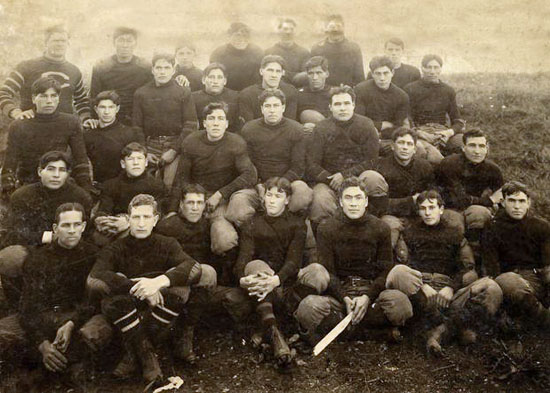
1907 Carlisle Football Team
By the time the 1907 season started, Warner believed his sixth Carlisle team was "about as perfect a football machine as I ever sent on the field." They would need to be excellent to survive the challenging schedule Pop had put together.
The Indians were the best box-office team in the USA, road warriors who attracted large crowds in the Northeast and Midwest. Far from just a curiosity, they were a fast, skilled football team known for their "trick plays" and forward passes.
The Indians won their first seven games, including victories over Penn State, Syracuse, and Pennsylvania all on the road. After a loss at Princeton in a game played in a steady rain that hampered Carlisle's passing attack, the Indians defeated Harvard in Boston 23-15.
Henry L. Williams' eighth Minnesota team provided the Indians' next challenge. Limited to five games by a Western Conference rule aimed at deemphasizing football, the Golden Gophers defeated Iowa State and Nebraska before losing to Chicago. An open date November 9 gave the Gophers two weeks to prepare for Carlisle.
Since Carlisle had shut out the Gophers the year before in Minneapolis 17-0 under the previous Indian coach, Warner was confident of victory. On the other hand, Minnesota fans hoped for a better outcome this time–if not victory, at least a much closer contest against the crafty invaders. They would get their wish.
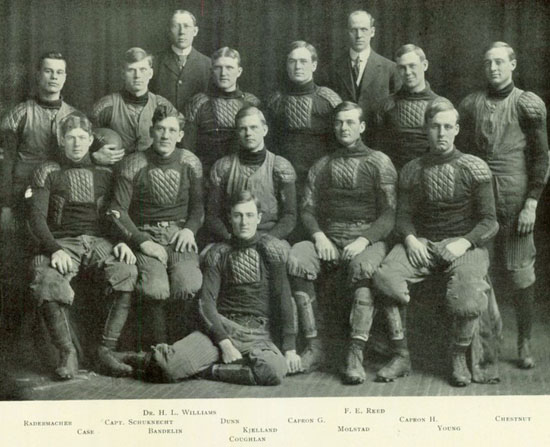
1907 Minnesota Football Team (Minnesota Gopher Yearbook, Class of 1909)
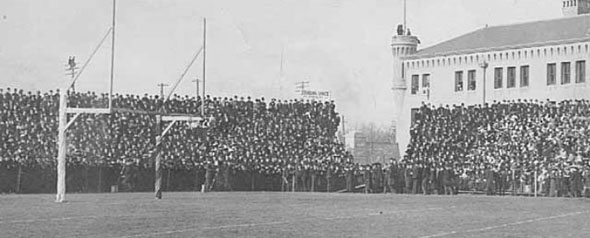
Northrop Field Minneapolis packed with 15,000 fans for the game against Carlisle
A light snow Friday night made the field somewhat slippery.
To show the tenor of the times, the summary of the game in the Minnesota Yearbook was headed "A Skirmish with the Aborigines." Carlisle was labeled the "terrors of the gridiron, conquerors of Minnesota's championship 1906 team, ..."
Minnesota started the scoring in the opening minutes. One of the "dusky men" (Indians), George Gardner, fumbled the kickoff, and Walter Rademacher recovered for the Gophers on the 23. After two running plays went nowhere, George Capron dropped back to the 35y line and drop-kicked the ball squarely through the uprights. 4-0 Minnesota
"The Indians then opened fire on us from ambush with trick plays and the forward pass. The 'scalpings' were two in number, both goals being kicked."
Forward passing had been introduced into college football in 1906 but with restrictions. Multiple Carlisle drives in this game ended because of the rule stating that a forward pass that hit the ground without touching a player of either side gave the ball to the defensive team.
The pigskin alternated between the teams for 15 minutes until Carlisle finally took possession on Minnesota's 40. A "criss-cross play around left end" moved the ball to the 22. Peter Hauser then broke through the line for a first down at the eight. After two plays failed to gain, QB Mount Pleasant threw a spiral pass over the heads of both teams to Antonio Lubo, who was standing on the one. He was tackled almost as soon as he caught the ball but fell over the goal line. Hauser kicked the extra point to put Carlisle ahead 6-4.
The second touchdown came on a 37y pass from Mount Pleasant to Exendine. Mount Pleasant added the point after. Carlisle 12 Minnesota 4
Halftime score: Carlisle 12 Minnesota 4
Minnesota Players

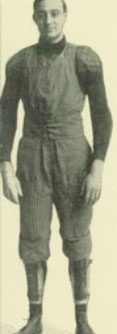
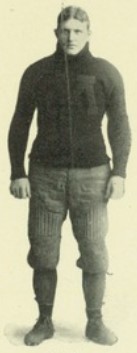
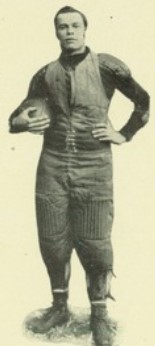
L-R: George Capron, Edward Chestnut, Captain Ney Dunn, Walter Rademacher
(Minnesota Gopher Yearbook, Class of 1909)




L-R: George Capron, Edward Chestnut, Captain Ney Dunn, Walter Rademacher
(Minnesota Gopher Yearbook, Class of 1909)
Minnesota dominated the second half. According to the yearbook writer, "The Gopher onslaughts on the Carlisle line were so terrific that seven redskins had to leave the game so badly were they used up." He added, "Minnesota played by far the best game in the second half on straight football, both on offense and defense, but poor generalship in directing the plays caused the Gophers to throw away at least two chances for a touchdown."
The Gophers ripped holes in the Carlisle line and marched downfield on gains of five, eight, and 10y at a time before bogging down. So Capron dropped back for a field goal from the 25, but the snap was wild.
A short time later, Minnesota began another march until they faced fourth down. This time the snap was true, but Capron's kick sailed wide. It was one of five field goal attempts he failed to make during the fray.
Minnesota's lone touchdown finally came on "one of the most spectacular plays ever seen on the Northrop field." Here's how the Gopher yearbook described it:
The Indians had the ball on our ten yard line, where they fumbled. The pigskin rolled out of the pile of players. It seemed an age before anyone wanted to notice it. But "Eddie" Chestnut spied it, sneaked over and picked it up, then started off on a mad chase for the Carlisle goal. He had a good lead, and Radermacher joined him to interfere. Down the field they cantered with the raging Injuns hot on the trail. At the middle of the field one Indian tried to drive for "Ches," but "Raddy" tumbled him. The other Redmen were gaining on the right flank. Straight as a string they fled down the sideline. But Eddie was good for it; the Indians were unequal to the task; with a forlorn hope, one of them jumped for "Raddy" as they came within a few yards of the line. Evidently he aimed to push him ahead and spill Chestnut. "Raddy" fell without touching him, however, and the other Injun dove in, nailing Chestnut as he slid over the line. Talk about excitement! No man, woman, or child took a breath during the progress of that thrilling run.
Captain Ney Dunn kicked the extra point. Carlisle 12 Minnesota 10
Play remained fierce. Minnesota got a chance to take the lead in the waning minutes when Gardner, a substitute for Exendine, was ejected for unnecessary roughness on a tackle. That put the ball on the Carlisle 35. Capron tried a drop kick from there that missed.
The game had a "rather peculiar ending." Here's the account from the Duluth News-Tribune:
Carlisle had just punted from their 20-yard line to Capron who made a beautiful return from his caught ball on his own 35-yard line to the center of the field. Just as the teams were lining up, the ball was near the sideline where the Carlisle subs were standing. Suddenly (Minnesota E William) Bandelin grabbed the ball and started down the sideline for the armory. As he was passing the Carlisle subs, Coach Warner reached out and grabbed the Minnesota player by the arm. Then it is alleged that Gardner, the Indian end who had been put out of the game a short time before for slugging, struck Bandelin and for a moment it looked as though a free-for-all fight would be the outcome.
The thousands of spectators swarmed on the field, and the Indians were rushed to the armory for protection.
The thousands of spectators swarmed on the field, and the Indians were rushed to the armory for protection.
Final score: Carlisle 12 Minnesota 10
Overjoyed that their heroes outplayed the visitors and lost by only two points, Minnesota students carried Schucknecht and several of his teammates from the field on their shoulders.
References
The History of American Football: Its Great Teams and Coaches, Allison Danzig (1956)
Pop Warner, Football's Greatest Teacher: The Epic Autobiography of Major College Football's Winningest Coach, Glenn S. (Pop) Warner, edited by Mike Bynum (1993)
Pop Warner: A Life on the Gridiron, Jeffrey J. Miller (2015)
The History of American Football: Its Great Teams and Coaches, Allison Danzig (1956)
Pop Warner, Football's Greatest Teacher: The Epic Autobiography of Major College Football's Winningest Coach, Glenn S. (Pop) Warner, edited by Mike Bynum (1993)
Pop Warner: A Life on the Gridiron, Jeffrey J. Miller (2015)